What do you do, in a world where you can’t go to the supermarket and pick up a can of Campbell’s Chunky Soup? Where you can’t call up Domino’s for a pizza?
Well… you’ll live a while on your food reserves. But after that…
…you’ll become a thief, a hunter or a gardener.
The first option is risky. Just think what happened with the horse thieves in the wild west. Plus, there are some people who would rather die than steal another’s food.
The second one will probably work for a month or so. If 300 million hungry Americans head out for the woods, how long will it take to exterminate the wild animals? We’ve already eradicated a few species.
When the remaining people will start to form communities, thievery will be the hardest way to “earn” a living. And when the wild animals become a rarity the hunting game will come to an end.
So… most of us will become gardeners
Agriculture didn’t just happen, it came out of gardening. Humans didn’t suddenly become farmers. They didn’t throw away their spears, stop hunting and round up cattle. Nor did they instantly stop foraging and start to grow fields of crops. In fact the transition to agriculture was gradual. Humans became gardeners, dropping the seeds of their foraged food and seeing them grow. Those early experiments by our forefathers and mothers, led eventually to a world driven by agriculture.
They also had to protect their crops against looters (tribes) just like in a post-apocalyptic scenario. Things were rough back then.
Related: Setting Up Home Defenses The Right Way (Video)
What’s important to remember though is that those early gardeners didn’t have commercial fertilizers to play with; those guys were gardening from scratch, no help except from nature and their own innovation, they were early gardeners.
We’re rapidly moving into a new world, one where we need to be prepared to go back to the days of using our own innovation to grow our own food. We need to bring back those skills to feed our families from a few sewn seeds.
Banking on Seeds
A modern phenomena that will come back to haunt the guerilla gardener, is the use of Genetically Modified Organism (GMO) based crops.
Growing seeds in a future that may be cold, dark and fertilizer free, will be even more difficult as we see butterfly, bee and other beneficial insects that help us to cross pollinate and grow our food, decline because of cultivation practices that Monsanto (for example) uses and promotes; practices that actually damage the environment, rather than optimize it.
Look out for ‘heirloom’ seeds. They’re seeds taken from old cultivar plants. Heirloom plants come from a wider diversity of plants and many of them have been cultivated with natural disease resistance through hybridization between plant species (see later about how to cross pollinate plants).
Creating Tough Seeds
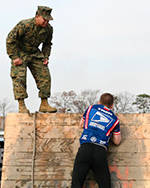 Seeds need to be optimized to give good crops, having resistance to disease and being hardy for specific conditions, such as drought or cold…
Seeds need to be optimized to give good crops, having resistance to disease and being hardy for specific conditions, such as drought or cold…
…especially drought, now that scientists from NASA have just predicted a 100 years Mega-Drought (Video).
Generating and collecting good quality seeds is crucial to creating robust and successive generations of plant. You can buy and start to store good seeds now, but these seeds may not be viable by the time you need to plant them. You are better placed to store some, but grow more. You can then collect the seeds from those plants for future planting.
However, you may, at some point need to generate your own good seeds using cross-pollination methods, which can give you more robust and disease resistant strains.
This takes some experimentation. The most common method of doing this is to take two sturdy vegetable plants and ‘cross pollinate’ them, that is take the pollen from one plant and place it on the stamen (inside the flower) of another – a good method of doing this is to use a fine paint brush, this is plant hybridization (Source).
When you eventually get a viable plant from this process, the seed from that plant is known as an F1-Hybrid and is often robust and can be highly disease resistant (I caveat this with the fact this takes trial and error experimentation).
Related: 68 Medicinal Plants That You Can Grow in Your Garden (and map with US medicinal plants, by state)
How to Collect Seeds
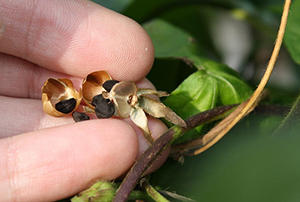 Collecting seeds is dependent on the plant, but certain general rules can be applied:
Collecting seeds is dependent on the plant, but certain general rules can be applied:
You can generally tell when the seeds are ready to collect because you’ll see a noticeable change in color in the plant, for example, green to brown. You can pick the heads of the plant, this is the part that contains the seeds, sometimes called a pod, and then leave it somewhere warm and dry. Once the pod has dried out, either the seeds will naturally fall out, or if the pod doesn’t open, you can gently crush it to release them.
Plants like berries are a little more difficult. The fruity part, containing the seeds needs to be crushed up, even mashed, through a sieve and the (often fine) seeds then need to be washed clean of any pulp. You can then leave them to dry by placing them on something absorbent, like a paper towel.
Nuts can be collected as they fall from the tree and released from their casing.
What is really important to remember with all seeds is to remove any extraneous material, such as casing, as this can rot down and become infected with fungus, effectively preventing the seed from germinating (i.e. growing).
Storing Seeds
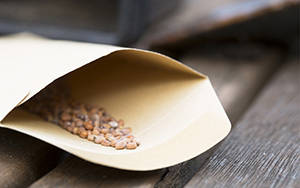 Once you have the seeds you collected yourself, or if you have bought in seeds from a supplier, you need to keep them safe and ready for planting. Seeds can last for years if kept in the right conditions. The ideal way to keep them is in paper. Make small paper packets for each seed type and place them in (don’t forget to label and date them). Then keep them cool, the cooler the better and in a dark place.
Once you have the seeds you collected yourself, or if you have bought in seeds from a supplier, you need to keep them safe and ready for planting. Seeds can last for years if kept in the right conditions. The ideal way to keep them is in paper. Make small paper packets for each seed type and place them in (don’t forget to label and date them). Then keep them cool, the cooler the better and in a dark place.
The seed must be dry before storage; if you can get hold of some calcium chloride, all the better, as this is a desiccant and so removes moisture. The exception to this rule is walnuts, which conversely must not be allowed to dry out.
Growing in Difficult Conditions (Post-Apocalyptic)
Now you’ve got your seeds, you need to know how to grow them. It took me seven years to truly understand how to grow plants from seed. If you don’t already garden, practice now. If you don’t have a garden, use pots – you can even grow indoors if needs be, but gardening is something that is best learned by practice and germinating seeds is an art as much as it is a science (tomatoes are particularly tricky).
Water shortages
Water is crucial for good crop production. If you have problems with drought you need to take measures to manage water shortages, collect water and store it for use on your crops. (Storing and Filtering Rain Water in a Barrel)
A fundamental thing to remember, not just for areas with low rainfall, is that good soil, which has a rich organic basis (ideally compost) will retain water better than poor soil.
You may, however, not have a lot of choice in your soil preparation at first, but you should bear this in mind and always generate compost from your waste.
 A useful trick to conserve water uptake by plants is to set them out in a block formation, rather than in rows – this reduces water loss and helps create shade. Or even better – Vertical Gardening (see picture)
A useful trick to conserve water uptake by plants is to set them out in a block formation, rather than in rows – this reduces water loss and helps create shade. Or even better – Vertical Gardening (see picture)
Related: How to Prepare For The Coming Food Crisis
Mulching is also a great way to stop water loss from the soil. Mulch is usually, some substance like torn up paper, or wood shavings and bark that is laid on the soil. However be careful what you use to mulch as certain woods, such as black walnut are poisonous to plants (see also notes on using a compost toilet below).
One useful method I have used to water vegetable plants frugally, is to use an upturned, plastic bottle, filled with water. You need to put a few holes into the cap of the bottle and place it upturned, next to the plant, the water drips out slowly, enough to keep the plant watered and it means you don’t waste water on unplanted ground.
Poor Light
There’s not a lot you can do if there is no light because vegetables love light. However, some vegetables can be grown in more shady and dappled areas. These include, broccoli, cauliflower, peas, spinach, kale, certain salad vegetable like lettuce and some beans.
No chemical Growing
Organic growing is something we can find out a lot about now. Many people across the world, in a variety of environments, grow vegetables organically, with no chemical fertilizers. And of course, our forebears did this too. It is a case of working with what you have. For example, human urine, which is sterile, is a well known fertilizer of vegetable plants as it is full of nitrogen and potassium. Giving your plants a personal watering does them a lot of good. On the subject of urine, compost toilets are an excellent idea and building one should be top of your agenda of things you need to know how to do. A compost toilet basically, composts your own waste products, which takes around 6 months. Once composted the resultant mulch can be used for plant food and as a way of controlling water loss from the soil.
Seeds for the Future with Ideas from the Past
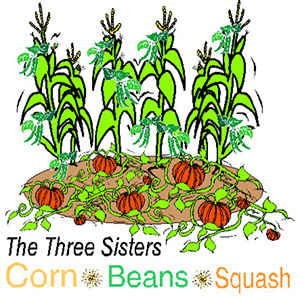 There’s a Native American gardening trick, known as the Three Sisters Garden which very cleverly uses the staple vegetable plants, squash, maize and climbing beans in ways which maximize the use of space and conditions so that each helps the other to grow more optimally. It is worth looking at this concept of co-operative planting and remembering that gardening needs thought, it will feed us, even help cloth us; it is a skill that each of us needs to learn.
There’s a Native American gardening trick, known as the Three Sisters Garden which very cleverly uses the staple vegetable plants, squash, maize and climbing beans in ways which maximize the use of space and conditions so that each helps the other to grow more optimally. It is worth looking at this concept of co-operative planting and remembering that gardening needs thought, it will feed us, even help cloth us; it is a skill that each of us needs to learn.
Another way is to have a system totally independent of the environment in a small, leveled space, like Aquaponics. Here you can find more details on how to build your own Aquaponic System.
We need to become gardeners to assure the future of our current and future family members.
“The greatest fine art of the future will be the making of a comfortable living from a small piece of land.” (quote – Abraham Lincoln)
You may also like:
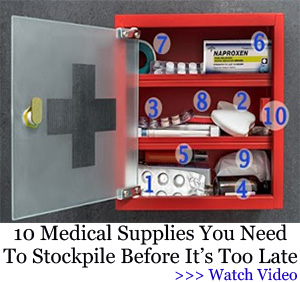 H2O Dynamo – The Awesome Device That Turns Air Into Water
H2O Dynamo – The Awesome Device That Turns Air Into Water
How To Build A Hidden Food Growing Fence In Your Backyard (Video)
Ingenious Foods People Made During Famines

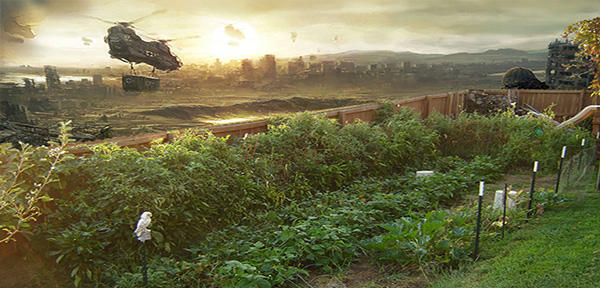










sounds interesting,,,
Great gardening information. I have only one comment to ad……..I’m a pretty lazy gardener so during the cold Ohio winter I throw my leftover veggies and fruit right into one of my three gardens and let mother nature do her thing in order to compost. I do collect grass clippings to provide moisture and weed control.
The human urine application to the garden is new to me but a very interesting concept although the neighbors would become quite unsettled to see me peeing in my garden! Great idea though in a SHTF situation.
Best,
Snake Plisken
“Extincted” should be “extirpated.” 😉 Or eradicated.
Thanks. I’ve just changed it.
Don’t forget Aquaculture, which is a combination of Hydroponics and indoor Fish-Farming. You need a low-voltage power source, such as a solar panel to run a small water pump. This is used to move water between plant growing beds and a tank for your fish, crayfish or whatever else. The fish poo provides nutrients for the plants, and the plants clean the water for the fish. There are many books on the subject.
I could be mistaken, but I believe solar panels will go out should a solar flare / EMP occur. One would have to have extra panels and have them in a faraday cage to protect them from damage.
Rob, you are wrong, solar panels can take a EMP and keep on working, tho power output may be reduced.
I wonder if a windmill could be put to use for the water pump and/or maybe airiation for the fish…
the Three Sisters plan does not work. I have tried it several times now. This year I managed to get Mayflower beans and used a Native American corn along with a squash. The squash did not grow so well and the beans took over the corn again tearing it down and ruining the corn crop. Not so impressed.
Planting corn, beans, and squash all on the same day in the same small plot of ground will never work.Three Sisters was used by Native Americans who had no metal technology–no plows, shovels, or axes. They burned down trees rather than cutting them with a stone ax, then planted corn around the stump. When the corn was 4-5 feet tall they planted beans to climb the stalks. The burned tree stumps were 10-20 feet apart so the area in between is where the squash grew, digging only a small hole for the seed and letting the vines sprawl across the untilled ground. The squash vines choked out most weeds which was good in a culture without metal garden tools or chemical weed killer.
Thank you for this. Very clear.
The same thing happened to me too. I thought it was because I had a very small space to garden.
Better begin learning to plant simple varieties now, select a few kinds that do well in your area and serve your table well. Skip trying to make hybrids just learn to select the best plants and save their seed a few seasons. Empty 2 l. bottles keep well dried bulk beans from year to year w/ tight lids. Added ash can keep any weevils from prospering in your bean seed. A faint sheen of oil on beans does so too. My QPM corn seed dried and canned in ’11 w/ O2 absorber sprouted 10 out of 10 in Jan.’16.
3 Sisters: Key besides using fish heads & guts 7″ under the hills is planting beans only when corn is 5″ high. See http://www.nativetech.org/cornhusk/threesisters.html Indians in Brazil discovered char in compost pile helped hold fertility of soil. See Terra preta in Wiki, etc.. Add 20-30% char in manure pile or composting toilet to control odor, then dig into row crops. (not root crops till well cured). Urine is usually germ free and has been used with success diluted with 4 parts water after seed are up, applying 1/2 cup mix weekly to corn plants after emerging up to near harvest. Avoid burning seed & sprouts with ash or contact with fertilizer. Apply any of these a few inches away under row or after plants are furthur along as top dressing. Incorporate biochar into soil with fish entrails or after curing it in compost pile or manure pile some weeks.
You mention F1 hybrids. I thought hybrids will only produce sterilized plants .Beautiful, but NO produce.Am I wrong?
Some gmo seed will be sterile. F1 hybrids will not breed true to the type of plant that you grew originally. Usually edible but not the same type. One parent for some traits, the other parent for others. In my garden v
olunteer tomato plants from F1 were ok but very soft skins and low production.
Here in the Sonoran Desert, we use unglazed clay pots called ollas (pronounced oyas) buried by the plants and filled with water. I guess they have been used since the Hohokam.
Then again, maybe not. The Hohokam dug extensive canals to grow their crops in the desert. However, that would not necessarily rule out their use of ollas.
check out keyhole gardening on YouTube!
I’m in AR, we plant corn on Valentine’s day, or close to then, or before. Corn can take the frosts. So, it would be pretty tall by bean and squash time, after frosts.
Freeze your seeds
The one BIG problem with aquaponics that none of the adverts seem to make mention of is the fact the fish need to be fed, for the system to run at all. Yes the WATER is recycled and the plants benefit but the plants do not supply food back to the fish since they are for us to eat. PLUS some systems rely on a constant power source to keep the water flowing. and need artificial lighting.
Then you need a good, constant supply of fingerlings (baby fish) so you either need a fairly large system to allow for all stages of the fish’s life, or someone who can supply them in a SHTF situation.
Sure you can jerry rig up something for the water transfer in that situation, and I guess you could stock years worth of those fish feeding pellets, but those details would have to be thought out BEFORE disaster hits.
Barbara, I know a guy who is experimenting with a small aquaponics system with Tilapia (fish) that he does feed with pellets and they have been reproducing so he put small sections of PVP pipe and terra-cota pots for the fry to hide in after hatching. They are reproducing more fish than the system could sustain so he gave me a few 8″ fish to thin them out and le the fry have a chance to grow. He said the clay pellets work pretty well as a growing medium but he is still trying to figure out which plants grow best for his system in our climate – hot and dry, and mild winters. He is trying to figure out how to get everything running correctly with a small solar powered pump and timer to keep the plants growing but not drown them.
Now that I’ve seen a small working backyard aquaponic system I have been thinking about how I might set one up myself, but I have other projects that must come first, like establishing a 20’x30′ garden with 2′ of hardware cloth as “underground fencing” to keep the gophers out, and some shade cloth overhead for July through September when it is often 90 – 100 degrees for weeks at a time.